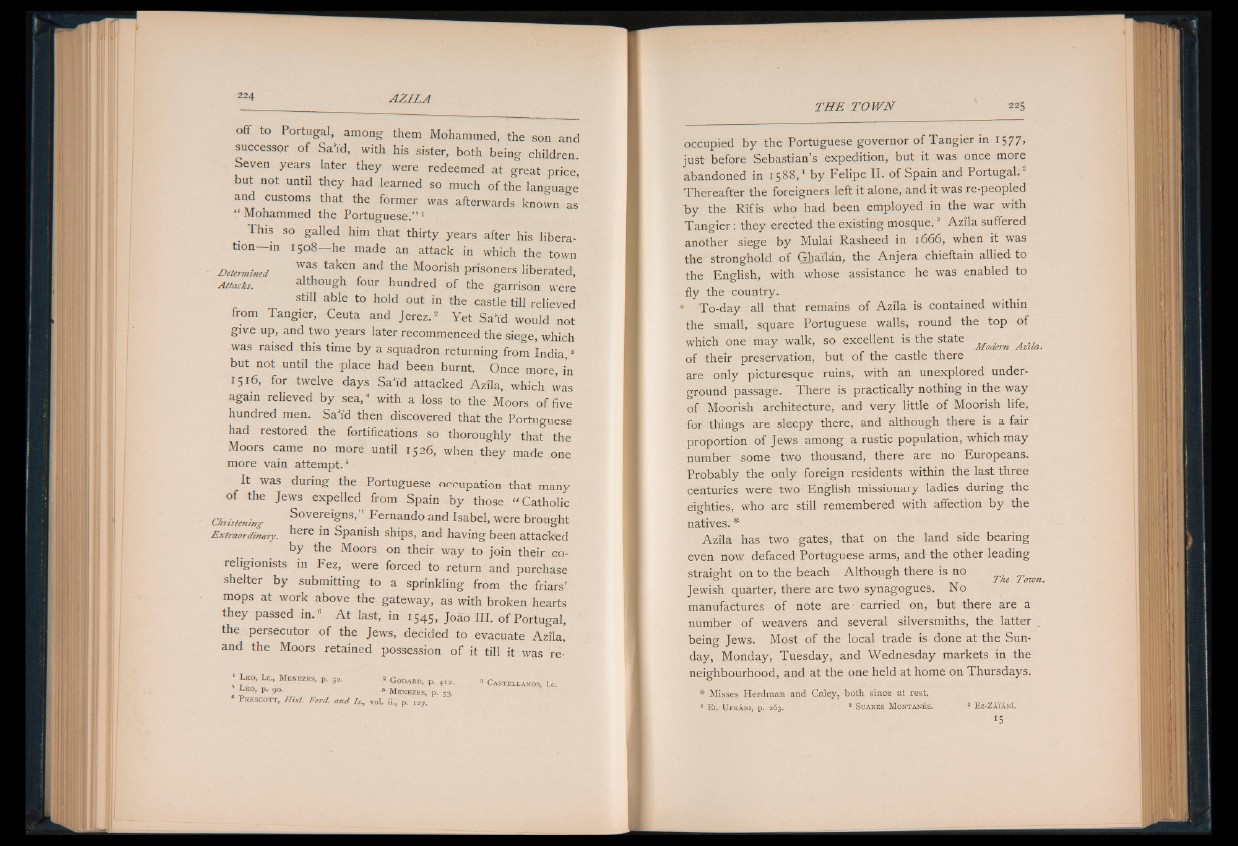
off to Portugal, among them Mohammed, the son and
successor o f Sa’id, with his sister, both being children
Seven years later they were redeemed at great price!
but not until they had learned so much of the language
and customs that the former was afterwards known as
“ Mohammed the Portuguese.” 1
This so galled him that thirty years after his liberation—
in 1508— he made an attack in which the town
Determined taken and the Moor>sh prisoners liberated,
Attacks. although four hundred o f the garrison were
still able to hold out in the castle till relieved
from Tangier, Ceuta and Jerez.3 Yet Sa’id would not
give up, and two years later recommenced the siege, which
was raised this time by a squadron returning from India 3
but not until the place had been burnt. Once more, in
1516, for twelve days Sa'id attacked Azila, which was
again relieved by sea," with a loss to the Moors o f five
hundred men. Said then discovered that the Portuguese
had restored the fortifications so thoroughly that the
Moors came no more until 1526, when they made one
more vain attempt.5
It was during the Portuguese occupation that many
of the Jews expelled from Spain by those “ Catholic
Christening Sovereigns, Fernando and Isabel, were brought
Extraordinary. here in Spanish ships, and having been attacked
by the Moors on their way to join their coreligionists
in Fez, were forced to return and purchase
shelter by submitting to a sprinkling from the friars’
mops at work above the gateway, as with broken hearts
they passed in .6 A t last, in 1545, Joao III. o f Portugal,
the persecutor of the Jews, decided to evacuate Azila,
and the Moors retained possession o f it till it was re*
L e o , I.e., M e n e z e s , p . 5 *. * G o d a k d , p . . 4 , 2 , * C a s t e l l a n o s , I.e.
L e o , p . 90. s M e n e z e s , p . 53.
“ P r e s c o t t , Hist. Ferd. and Is., v o l. ii., p . i 2 7 .
occupied by the Portuguese governor of Tangier in 1577,
just before Sebastian’s expedition, but it was once more
abandoned in 1588,1 by Felipe II. of Spain and Portugal.
Thereafter the foreigners left it alone, and it was re-peopled
by the Rifis who had been employed in the war with
Tangier: they erected the existing mosque.3 Azila suffered
another siege by Mulai Rasheed in 1666, when it was
the stronghold of Ghailan, the Anjera chieftain allied to
the English, with whose assistance he was enabled to
fly the country.
\ To-day all that remains of Azila is contained within
the small, square Portuguese walls, round the top of
which one may walk, so excellent is the state Modern Aztla
of their preservation, but of the castle there
are only picturesque ruins, with an unexplored underground
passage. There is practically nothing in the way
of Moorish architecture, and very little of Moorish life,
for things are sleepy there, and although there is a fair
proportion of Jews among a rustic population, which may
number some two thousand, there are no Europeans.
Probably the only foreign residents within the last three
centuries were two English missionary ladies during the
eighties, who are still remembered with affection by the
natives. *
Azila has two gates, that on the land side bearing
even now defaced Portuguese arms, and the other leading
straight on to the beach Although there is no '
Jewish quarter, there are two synagogues. No
manufactures of note are carried on, but there are a
number of weavers and several silversmiths, the latter
being Jews. Most of the local trade is done at the Sunday,
Monday, Tuesday, and Wednesday markets in the
neighbourhood, and at the one held at home on Thursdays.
* Misses Herdman and Caley, both since at rest.
1 E l U f r a n i , p . 263. 2 S u a r e s M o n t a n e s . 3 E z -Z a iAn i . 15